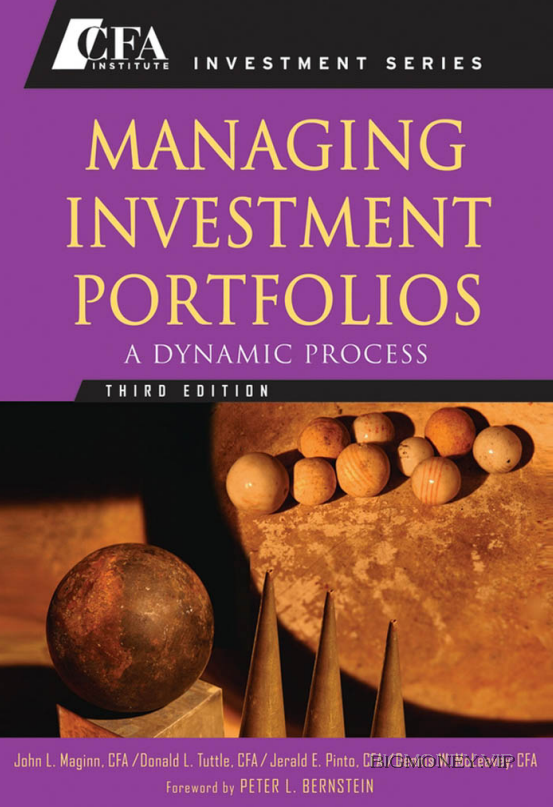MANAGING INVESTMENT PORTFOLIOS: A DYNAMIC PROCESS. Third Edition by John L. Maginn, Donald L. Tuttle, Dennis W. McLeavey, Jerald E. Pinto

CHAPTER 1
THE PORTFOLIO
MANAGEMENT PROCESS
AND THE INVESTMENT
POLICY STATEMENT
John L. Maginn, CFA
Maginn Associates, Inc.
Omaha, Nebraska
Donald L. Tuttle, CFA
CFA Institute
Charlottesville, Virginia
Dennis W. McLeavey, CFA
CFA Institute
Charlottesville, Virginia
Jerald E. Pinto, CFA
CFA Institute
Charlottesville, Virginia
1. INTRODUCTION
This chapter introduces a book on managing investment portfolios, written by and for invest-
ment practitioners. In setting out to master the concepts and tools of portfolio management,
we first need a coherent description of the portfolio management process. The portfolio
management process is an integrated set of steps undertaken in a consistent manner to create
and maintain an appropriate portfolio (combination of assets) to meet clients’ stated goals. The
process we present in this chapter is a distillation of the shared elements of current practice.
Because it serves as the foundation for the process, we also introduce the investment policy
statement through a discussion of its main components. An investment policy statement
(IPS) is a written document that clearly sets out a client’s return objectives and risk tolerance
over that client’s relevant time horizon, along with applicable constraints such as liquidity
needs, tax considerations, regulatory requirements, and unique circumstances.
The portfolio management process moves from planning, through execution, and then
to feedback. In the planning step, investment objectives and policies are formulated, capital
market expectations are formed, and strategic asset allocations are established. In the execution
step, the portfolio manager constructs the portfolio. In the feedback step, the manager monitors
and evaluates the portfolio compared with the plan. Any changes suggested by the feedback
must be examined carefully to ensure that they represent long-run considerations.
The IPS provides the foundation of the portfolio management process. In creating an
IPS, the manager writes down the client’s special characteristics and needs. The IPS must
clearly communicate the client’s objectives and constraints. The IPS thereby becomes a plan
that can be executed by any adviser or portfolio manager the client might subsequently hire. A
properly developed IPS disciplines the portfolio management process and helps ensure against
ad hoc revisions in strategy.
When combined with capital market expectations, the IPS forms the basis for a strategic
asset allocation. Capital market expectations concern the risk and return characteristics of
capital market instruments such as stocks and bonds. Thestrategic asset allocation establishes
acceptable exposures to IPS-permissible asset classes to achieve the client’s long-run objectives
and constraints.
The portfolio perspective underlies the portfolio management process and IPS. The next
sections illustrate this perspective.
2. INVESTMENT MANAGEMENT
Investment management is the service of professionally investing money. As a profession,
investment management has its roots in the activities of European investment bankers
in managing the fortunes created by the Industrial Revolution. By the beginning of the
twenty-first century, investment management had become an important part of the financial
services sector of all developed economies. By the end of 2003, the United States alone
had approximately 15,000 money managers (registered investment advisers) responsible for
investing more than $23 trillion, according to Standard & Poor’s Directory of Registered
Investment Advisors (2004). No worldwide count of investment advisers is available, but
looking at another familiar professionally managed investment, the number of mutual funds
stood at about 54,000 at year-end 2003; of these funds, only 15 percent were U.S. based.
The economics of investment management are relatively simple. An investment manager’s
revenue is fee driven; primarily, fees are based on a percentage of the average amount of assets
under management and the type of investment program run for the client, as spelled out in




